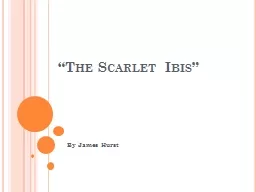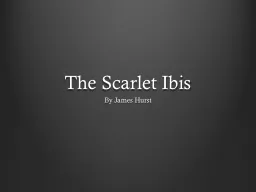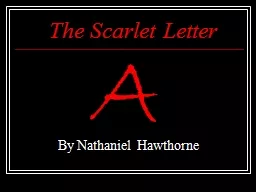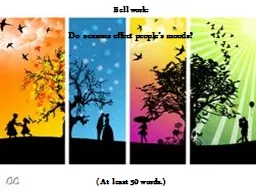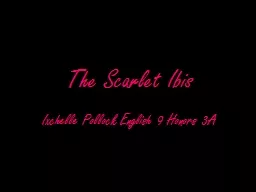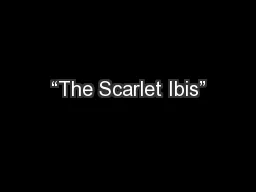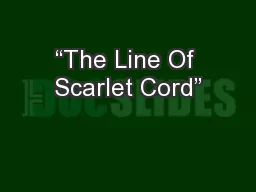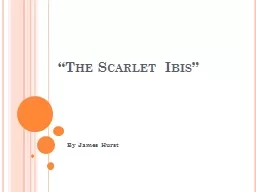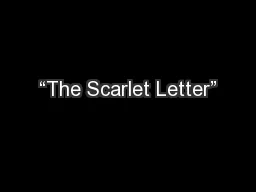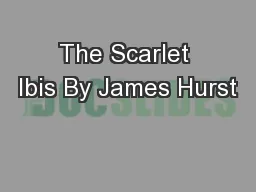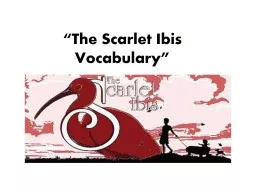PPT-“The Scarlet Ibis”
Author : lois-ondreau | Published Date : 2016-04-30
By James Hurst the Clove of seasons Clove is a noun here from the verb to cleave or to split A cleaver is a knife used by butchers Cloves are a spice The clove
Presentation Embed Code
Download Presentation
Download Presentation The PPT/PDF document "“The Scarlet Ibis”" is the property of its rightful owner. Permission is granted to download and print the materials on this website for personal, non-commercial use only, and to display it on your personal computer provided you do not modify the materials and that you retain all copyright notices contained in the materials. By downloading content from our website, you accept the terms of this agreement.
“The Scarlet Ibis”: Transcript
By James Hurst the Clove of seasons Clove is a noun here from the verb to cleave or to split A cleaver is a knife used by butchers Cloves are a spice The clove of seasons is the split between two seasons not quite summer and not quite fall. Though your sins are like scarlet, they shall be as white as snow; though they are red as crimson, they shall be like wool. Is 1:18. Fanny J. Crosby, 1820-1915. COMPASSION. CCLI #977558. 1. “Though your sins be as scarlet, they shall be as white as snow;. By James Hurst. “Bleeding” Tree. Baby born in a caul. Baby born in a caul. Doodlebug (. Antlion. ). Doodlebug (. Antlion. ). Kids in 1920. Kids in 1920. N. Carolina Swamp. N. Carolina Swamp. World War I. By Nathaniel Hawthorne. Nathaniel Hawthorne. Hawthorne wrote . The Scarlet Letter. in 1850 during the Romantic Period in American Literature. Hawthorne is the ancestor of Judge John Hathorne known for his involvement in the Salem witchcraft trials.. Do seasons effect people’s moods? . (At least 50 words.). Objective:. Students will analyze word choice, setting, mood, and characterization by annotating the opening paragraphs of “The Scarlet Ibis.” . Ixchelle Pollock English 9 Honors 3A. James Hurst. James Hurst was born January 1, 1922 in Jacksonville, North Carolina. He went to North Carolina State College and studied chemical engineering. Also he did military service during WWII . He then went to Julliard School of Music in New York and Italy to become an opera singer. In 1951 he changed his mind AGAIN and became a banker in New York for an amount of time. He liked to write plays and stories whenever he could. “The Scarlet Ibis” was written in July 1960 and earned “widespread recognition”. James Hurst then passed away on August 6, 1995. Leaving his wife . Symbolism. Maria Ortega 1B. “The last graveyard flowers were blooming, and their smell drifted through every room of our house, speaking softly the names of our dead.”. This quote shows that Doodle and the Ibis resemble each other because they both die and it also connects to Doodle because they first gave him a name that would look nice on a tomb stone.. pp. 333-344. “The Scarlet Ibis” . pp. 333-344. Summary. : The narrator has to care for his younger brother Doodle, who is physically disabled. The narrator is frustrated by this burden, but succeeds in teaching Doodle to walk. After the narrator leaves Doodle in the middle of a storm, Doodle dies trying to meet the narrator’s expectations.. Joshua 2:17-18. Joshua 2:17-18. “So the men said to her: “We will be blameless of this oath of yours which you have made us swear, unless, when we come into the land, you bind this line of scarlet cord in the window through which you let us down, and unless you bring your father, your mother, your brothers, and all your father's household to your own home.”. . . .the “Clove” of seasons. Clove is a noun here – from the verb “to cleave” or to split. . A cleaver is a knife used by butchers. . Cloves are a spice. . The clove of seasons is the split between two seasons – not quite summer and not quite fall.. Nathaniel . Hawthorne . (1804-1864). Was one of two great novelists of the mid-. ninteenth. century (the other being Melville). Born in Salem, Mass., where his family had lived for six generations. Earliest ancestors were Puritans. . Scarlet Ibis . (Seaworld.org). An exotic red bird. Solid scarlet except for black wing tips; bill is long, thin and curved downward; neck is long and slender; legs are also long and thin with partially webbed feet; juveniles are dull, grayish . 2013-2014. Warm-up #1 . Vocabulary Unit 3 10/07/13. Take out Vocabulary Unit 3 and prepare to say each word and definition together with the class! (. Write each . word only in . this space). Caul (N). a. . part. of the . amnion. sometimes covering the head of a child . at. . birth.. . Careen (V). (of. a vehicle) to lean, sway, . or. tip to one side while in . motion:. . The. . car. Page 1 of 2 This leaflet offers more information about Scarlet Fever. If you have any further questions or concerns, please speak to the staff member in charge of your child’s care. What is Scar
Download Document
Here is the link to download the presentation.
"“The Scarlet Ibis”"The content belongs to its owner. You may download and print it for personal use, without modification, and keep all copyright notices. By downloading, you agree to these terms.
Related Documents

